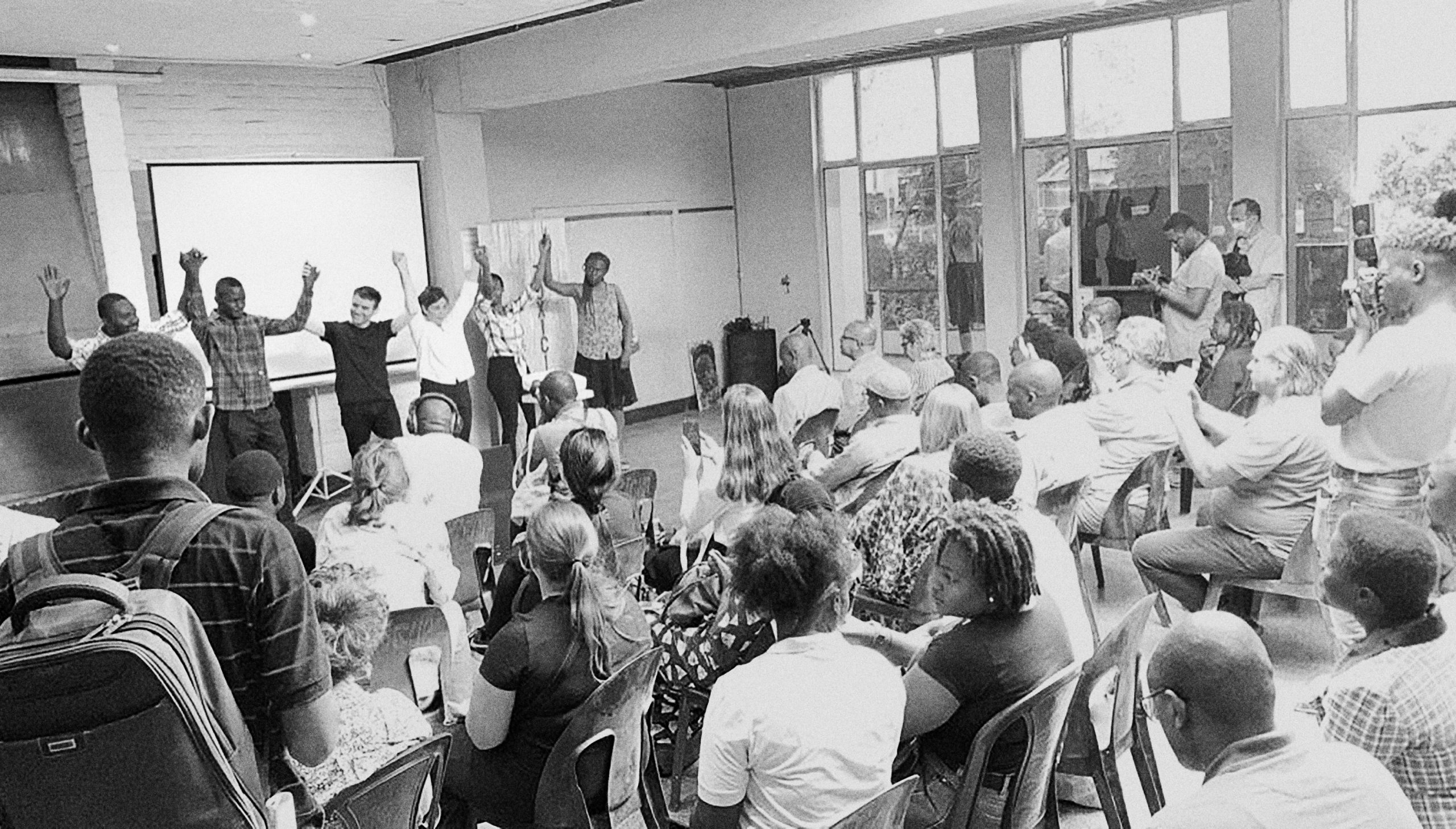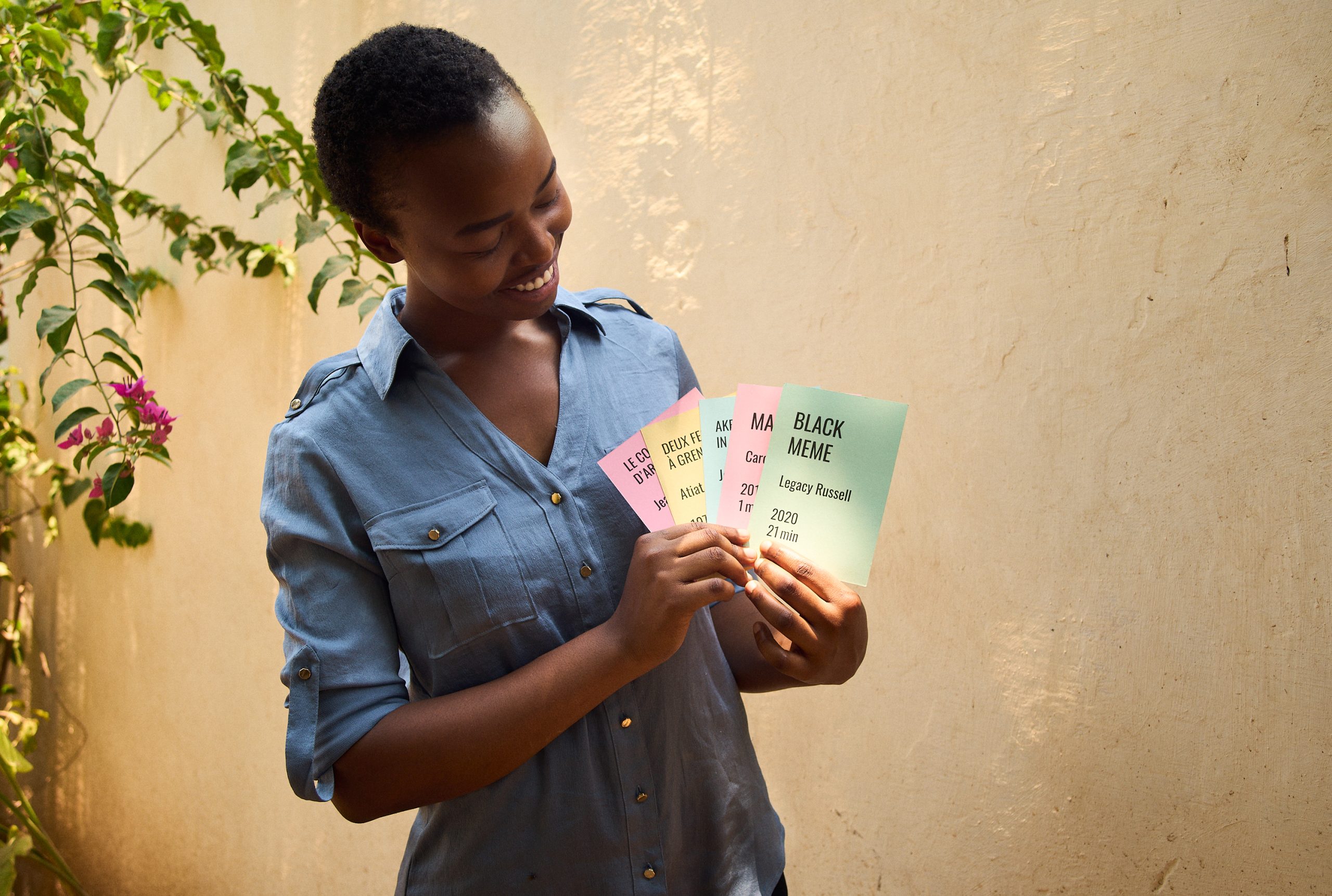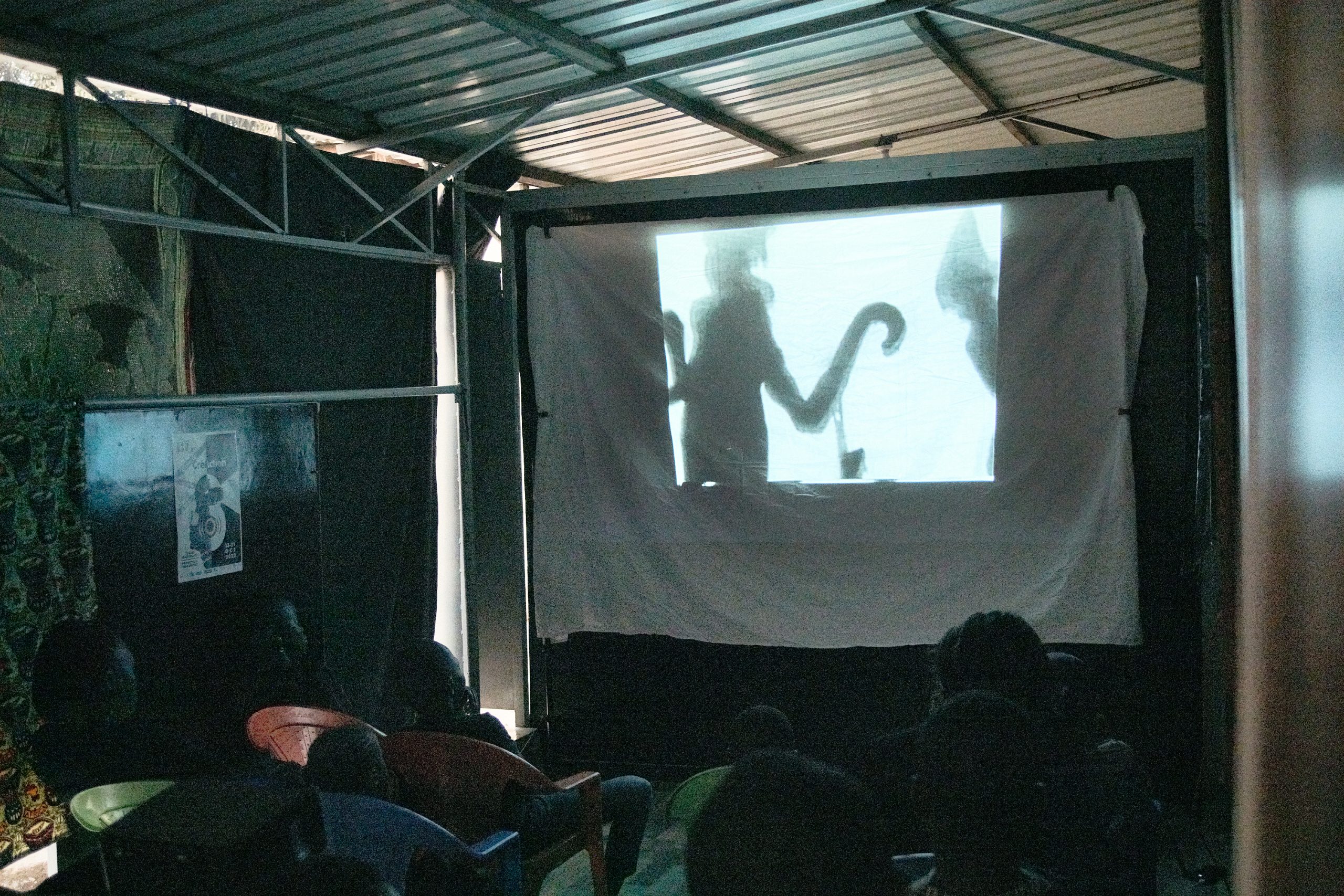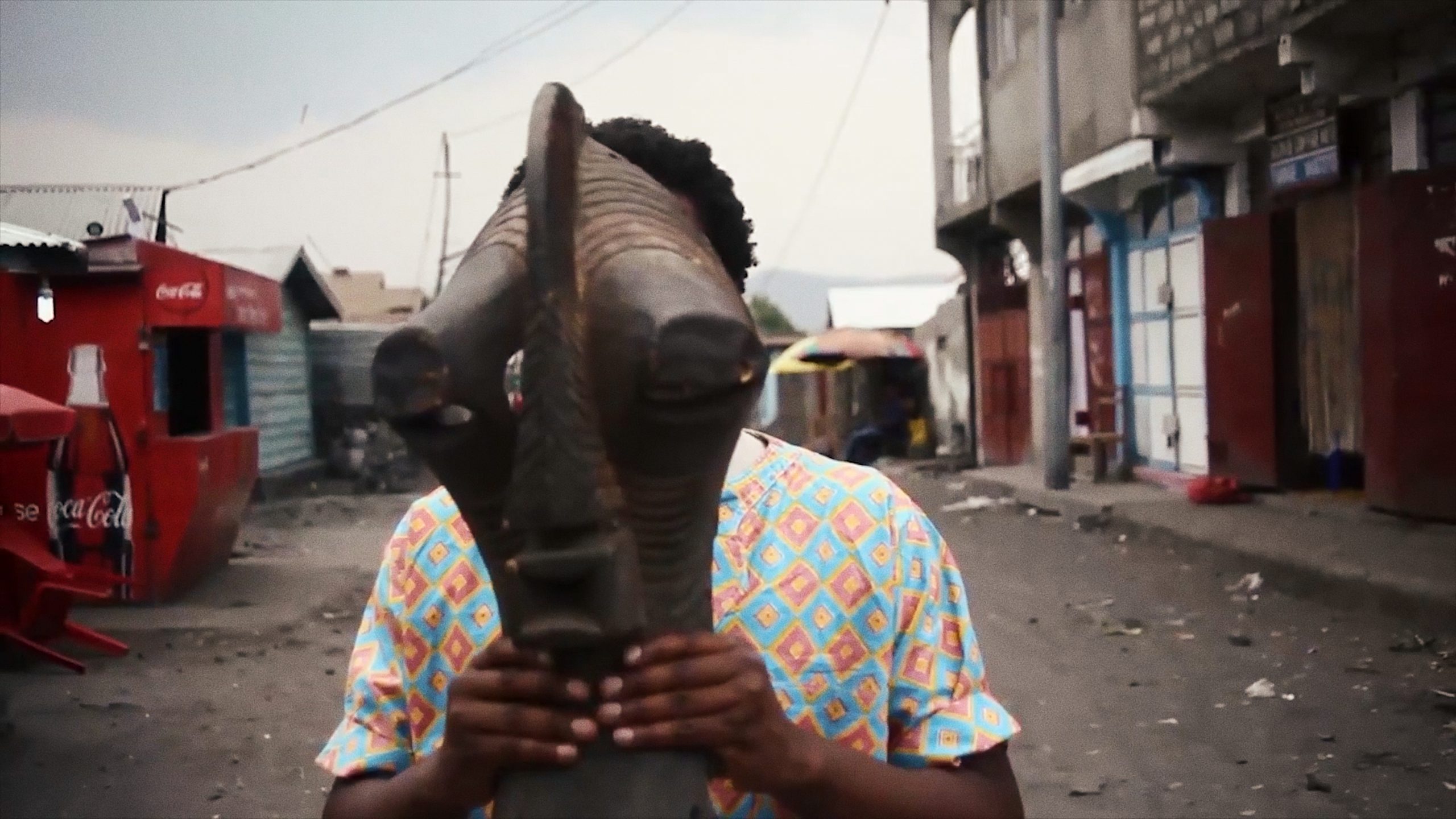Like other art forms, film can be thought of as a way to narrate histories, generate critical discourse and most importantly, bring communities together. Part of this is reflected in what artist and filmmaker Maria Iorio contemplates as, “the self-reflexive power of cinema to thematise its own histories, its independent modes of production and engage with publics.”
In 2022, a group of art practitioners came together through discussions and viewings on African film practice, particularly Congolese film practice, through the Lubumbashi Biennale. What has since emerged is the Jamii ya sinema.club — a long-term project coalescing informal exchanges, study and collective research. The project was initiated by Swiss artist duo Maria Iorio and Raphael Cuomo with Jackson Bukasa, Melissa Jina, Fils Ngeleka, Bibatanko Tankama and Lucrezia Cipitelli developed in the context of the 7th Lubumbashi Biennale titled ToxiCity.
I had the great privilege of chatting with the members of Jamii ya sinema.club about the work they are engaged in. Below is an excerpt from the interview, which was translated from French by Simon Chapman.

Nkgopoleng: Can you tell us about the impetus behind the platform Jamii ya sinema.club? What led to its creation?
Maria: Jamii ya sinema.club was initiated after meetings and discussions in the Ateliers Picha, which began in late 2021, early 2022. Lucrezia Cippitelli, the artistic director of the programme and curator of the 7th Lubumbashi Biennale (2022), had previously invited us for a residency in Lubumbashi, which would have involved intensive exchanges with the artists taking part in the Ateliers’ programme. Still, unfortunately, the various measures linked to the global pandemic prevented that initial stay. So, we tried to find alternative ways to have regular meetings with the group online and to get around the impossibilities (travel, meetings, etc.) created by these circumstances.
We knew that the participants in the Workshops’ programme were very interested in the moving image and film – an interest we share and that is closely linked to our practice as artists and filmmakers [based in Geneva and Berlin]. The initial impetus came from what the group asked for, from a need to watch and discuss, to discover, and to deepen our understanding of filmmaking practices that, today, cut across the boundaries between established artistic fields, from cinema to contemporary art, and that also shape various contemporary visual cultures, as well as touching performance and the narrative arts, etc.
In very concrete terms, the context of Lubumbashi and the DRC, where there are hardly any cinemas anymore, showed how limited access to works and to films is while revealing other forms of circulation of moving images and of the reception of films. Beyond the hegemonic presence of certain cinemas, such as Hollywood cinema or Nigerian cinema, we also saw that the European cultural institutes, which, as elsewhere on the African continent, promote national creation (or according to linguistic rationales), while they offer welcome access to a part of historical and contemporary production, also contribute to the fact that another part remains totally invisible.
Furthermore, the “international” art system has the rather paradoxical, violent effect of sucking artists and their works away from the global South to the North: this means that some films made by contemporary Congolese filmmakers and artists may achieve a certain success in Europe and the USA, but simply never get shown in the local context, that of their production. Audiences and peers don’t have the chance to see works that achieve critical success elsewhere or to discuss them.

Raphaël: Another defining aspect came from the unique experiment we were attempting collectively — is it possible to watch a film together when you’re thousands of kilometres apart? Because it really was a collective experiment, which allowed us to share a film by trying to synchronise our attention — or rather, by trying to attune our phase shifts, by accepting the latencies, the delays, and the gaps, which became opportunities for discussion, reflection, debate, and laughter. At a certain point, we realised that our practice was approaching that of a ciné-club, that we were rediscovering – or reinventing – a sort of film society. Before long, this experiment, undertaken first with the Ateliers’ group, was opened to other participants, some physically present, some online on several continents. Various guests were involved in it, and they contributed by presenting their works and their knowledge.
This experiment revealed situated – and often little-known – histories that throw the Eurocentric, national, canonical versions of art and cinema history into crisis. It suggested fields of possible action and decolonial, transnational and Pan-African horizons for these practices. Knowledge was able to be shared, different affinities were able to associate and commitments to form alliances. The starting point for Jamii ya sinema.club was the realisation that you need to think beyond existing borders, and, also, that you need to actively create networks for informal exchanges, solidarity and reciprocity, to help face the present emergencies.
A small working group – comprising of Jackson Bukasa, an actor, filmmaker, and coordinator of Ateliers Picha in Lubumbashi, DRC; Melissa Jina, a visual artist and painter based in Lubumbashi, DRC; Fils Ngeleka, a PhD student, filmmaker, scriptwriter and blogger based in Lubumbashi, DRC and Bibatanko Tankama a writer based in Lubumbashi, DRC – pursued this process more actively by creating a screening programme and a Web platform, which were launched publicly during the Lubumbashi Biennale in October 2022.

Nkgopoleng: I’m interested in your reflections on the medium of film in Africa, particularly in the DRC. How would you describe the cinema culture in Lubumbashi at this moment? In what ways are audiences engaging with the medium?
Maria: The 2022 Lubumbashi Biennale proposed tackling clusters of problems under the title ToxiCity. This term made us think of the criticism of the dominant cinema as a cinema of intoxication. This criticism of Hollywood cinema and, more widely, of the cinema of the North, has been articulated by many African filmmakers and theorists and has had a meaningful impact: it has led to various attempts, on the continent, to liberate and decolonise screens so as to allow the emergence of truly African images and stories, of an African cinema. Jamii ya sinema’s programme revisits this history through its interest in the films or the actions of pioneering figures such as Tahar Cheriaa, who in his youth was one of the founders of Tunisia’s ciné-club culture, who later founded the Journées cinématographiques in Carthage, and who did a lot of work for cinema by blazing trails that could connect the north and the south of the continent. In Mohamed Challouf’s film portrait of him, Tahar Cheriaa – À l’ombre du baobab (2014), Heile Gerima observes that “the history of African cinema gives us a sense of continuity. If we want to understand how it was born, well, when we meet Tahar, we understand that African cinema was born out of struggle…”
This struggle for autonomy, self-representation, and self-determination can also be found in the films of the first women filmmakers to appear on the continent, such as Ateyyat El Abnoudy and Selma Baccar, to whom the programme pays homage: with cinema, it’s also the emergence of other visions and other subjectivities, other distributions of the sensible become possible. The power of cinema and art is transformative; one of the issues of this project is to reflect on the conditions that allow such emergencies, despite all the difficulties. And to understand how these past experiences concern our present, or what they have made possible today – to quote from the title of a fine text by Alia Ayman and Nour El Safoury dedicated to Ateyyat El Abnoudy and published on jamiiyasinema.club. Jamiiyasinema.club devoted a session to Ateyyat El Abnoudy’s early films made in the 1970s and a presentation in the Écran public section to L’éveil (1967), the first film made by Selma Baccar as a member of the Club Hammam-Lif of the Association of Young Tunisian Filmmakers, which became the Tunisian Federation of Amateur Filmmakers (FTCA) in the mid-1960s.

Fils: Regarding film culture in the DRC and in Lubumbashi, the term that springs to mind is: fallow land. That’s the phrase I have to use to describe the situation of film in the DRC. Films have become one of the biggest attractions. The broadcasting of films, mainly series, is the core of the flourishing economy of the providers of digital terrestrial TV services. With digital TV, which remains the main access channel, cinema seems never to have aroused so much interest. Beyond the wishes of a vast audience, the majority, to watch films, there’s a love affair between young people and the art of film and the making of films. But these possibilities are struggling to be fully expressed for want of a formal context.
In Lubumbashi, film is a relatively important medium. It attracts a lot of interest from the public and artists. The public watch films mainly on TV. Foreign TV series are the most viewed thanks to the soaring penetration of digital terrestrial TV. But people don’t go to cinemas anymore. There are hardly any cinemas left. Other possibilities for accessing films, such as independent screenings, are scarce. Filmmaking is in its infancy and has yet to find itself – find its audience, its context, its economic model, etc. Setting aside this contextual handicap, which is linked to an absence of structures for training and for the production and distribution of films, it has an abundant resource of young people in love with “the seventh art” and who are finding ways to tell their stories. The broadcasting and making of films are being learned outside of formal settings. Up until now, they have been independent initiatives.
Jackson: While there’s a tremendous interest in film among the Congolese, for example, casting calls receive a big response, there’s little understanding of the experience of and the obstacles faced by those who make films. One big difficulty that independent filmmakers encounter is that film culture, unfortunately, is ignored by public decision-makers. Filmmakers make do with what’s to hand, from writing the scenario to postproduction to distribution. Apart from financial problems or those linked to the lack of training structures, another thing I’ve noticed is that, sadly, some filmmakers, even though they have smartphones and computers with online access, don’t read enough, and don’t take advantage of shared resources and information. Various structures organise meetings, but few filmmakers take part in them. They do too little research where film is concerned.

Nkgopoleng: Can you tell us about what you have planned in your program for the year 2023? As well as how and where audiences can engage with Jamii ya sinema, particularly those outside of Lubumbashi.
Maria: The working group thought it was important that the temporality of this project shouldn’t be limited to one event, but that it should continue, regularly, after the frenzy of the Biennale, following its own rhythm and dynamics. We have been fortunate to receive support from several partners (special thanks to the Johannesburg office of Pro Helvetia and the Contemporary Art Fund (FMAC) of the City of Geneva) which will keep the project going over the coming months. The work Jamii ya sinema.club is doing is quite modest, but we hope it will inspire or facilitate other local initiatives, enable synergies to come together and, if possible, stimulate the local community in the longer term.
Since December 2022, the programme has continued to focus on contemporary Congolese cinema and films made by contemporary Congolese filmmakers, not only those made in Lubumbashi but also in other DRC contexts. Primo Mauridi presented his superb film Mawe (2022) at the session held on 22nd October 2022 at Lubumbashi University’s Faculty of Letters, which also included Kumbuka (2021) by Petna Ndaliko Katondolo; after meeting him in Lubumbashi, we invited him to develop with us a programme that concentrates on the specific context of Goma, where he currently lives and works, and where he is also involved in the organisation of a ciné-club at Yolé!Africa. His selection concentrated on the film Mwana Pwo (2019) by the artist Mugabo Baritegera (the film is currently in the Écran public section at jamiiyasinema.club) Guest curators continue to forge and strengthen links between the artistic communities. So Jamii ya sinema.club is developing as artistic encounters and friendships develop, leading to new collaborations. Upcoming programmes will continue to showcase emerging local production, the Kinshasa film scene, also, productions by the African diaspora. There’s a particular focus on young women filmmakers. We will have the opportunity to devote an upcoming session to Amelia Umuhire, a talented Rwandan-German filmmaker based in Berlin.

The Jamii ya sinema.club project is characterised by its aim to develop several reception contexts and to try out different kinds of cinema experiences. On the one hand, the programme sessions are physical screenings; they take place monthly, are aimed specifically at the Lubumbashi public and move between different parts of the city: Picha, Lubumbashi University, the Kidogo Kidogo Festival, the French Institute and Biasasa Art Centre. This will remain the organising principle until at least the summer of 2023. We also hope to develop a cycle of presentations internationally at the end of this cycle.
On the other hand, there is also a selection online on the jamiiyasinema.club website, in the Écran public section. The website is an important element and is there to do more than merely announce the programme. Its purposes include the thematisation of alternative modes of film production, distribution, and circulation – in particular films whose makers have themselves decided to make public online for aesthetic reasons (for works in the desktop cinema category) or as a deliberate choice to distribute freely. The site becomes a “shadow platform” – to use the term suggested by Jacopo Rasmi – whose purpose is not only to present these films but also to offer contextualisation and insights, new editorial content in the form of essays by critics and filmmakers, the republication or translation of hard-to-find texts, the presentation of documents, interviews with filmmakers, etc.
This story is produced in the context of an editorial residency supported by Pro Helvetia Johannesburg, the Swiss Arts Council.




















































